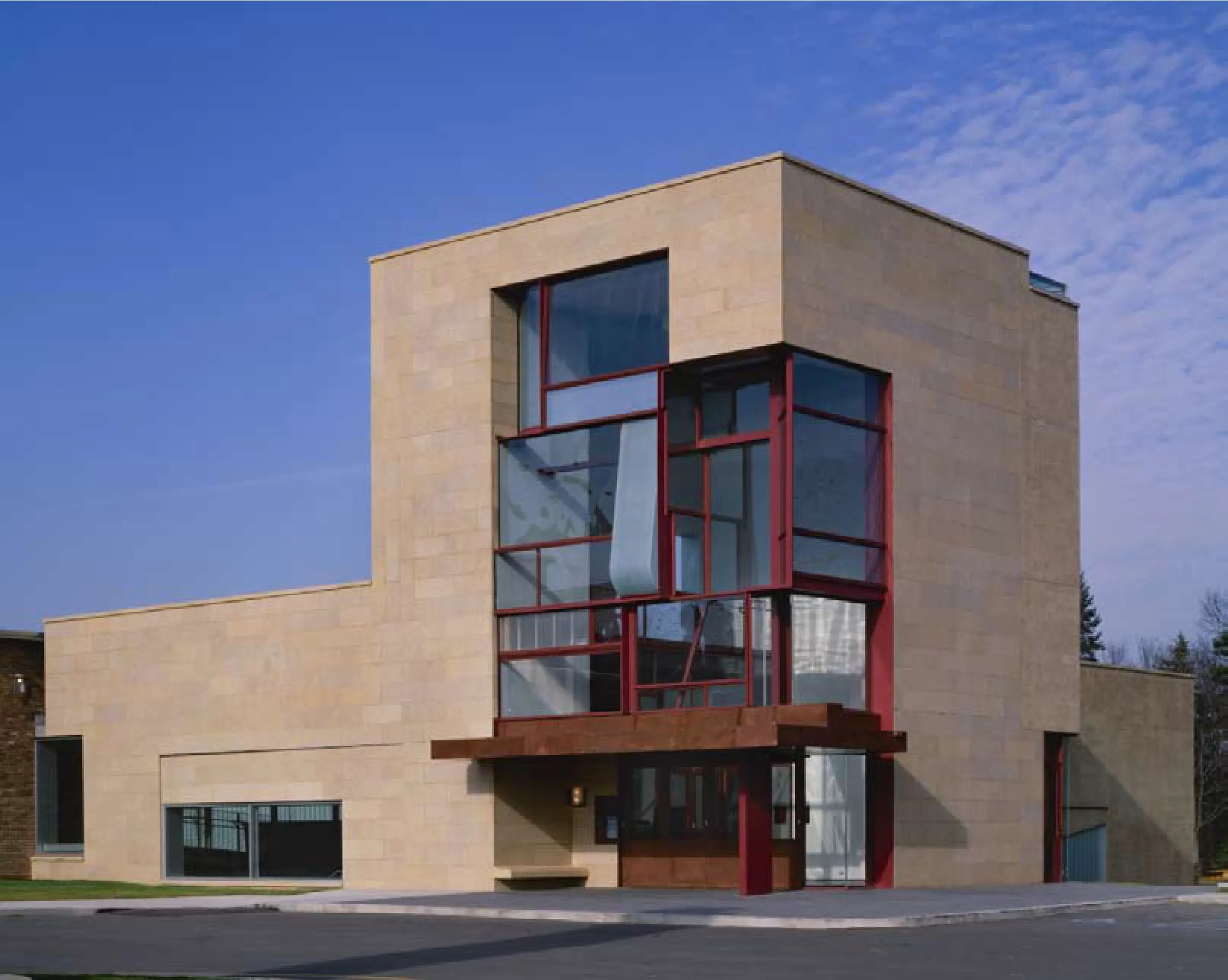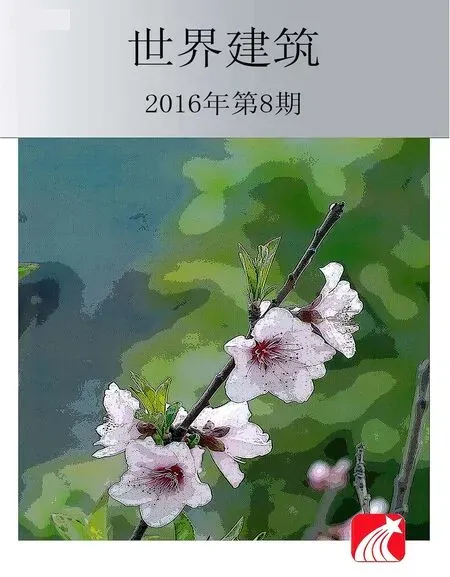匡溪科学研究所,布隆菲尔德山,密歇根,美国
匡溪科学研究所,布隆菲尔德山,密歇根,美国
建筑设计:斯蒂文·霍尔建筑师事务所Architects: Steven Holl Architects
场地策略
外部空间的塑造及与实体建筑的组织,赋予了匡溪校园清晰的特色。而在匡溪科学研究的加建项目中,我们将这一特征进行了延续。设计的目标在于尽可能减少对原有沙里宁建筑作品的扰动,同时尽可能增加潜在流线与参观体验。
新的内部庭园以倾斜和折叠的连接方式,形成了由花园至外部校园空间高程的柔和衔接。西北角的加建空间悬跨于地面之上,创造出一种自校园平面的“渗透性”过渡方式,提供了面朝花园展览的空间导向,以及开放而友好的空间感受。一条名为“无法解释的阶梯空间”的轴线自新的入口空间开始形成,大略与现存的“中华犬之坡”平行。这条新的动线将研究所与东侧现存沿缓坡地面延伸的自然小径连接到一起。
建筑概念
加建建筑将1937年保存至今的展馆空间“矿物厅”与“人类厅”中的尽端流线重新打开。建筑以平置的U型布局,如同描述科学中“奇异吸引子”的图解一般,在展览区域与研究所其他功能之间创造了多样化的路径。与此概念类似,斯蒂文·霍尔建筑师事务所试图令增建空间以自由、开放的方式存在,并能轻易适应后续的改造。建筑中的环线组织很独特,因而很可能每个来到新科学博物馆的参观者都将经历毫无重复的参观体验,与这座建筑的每一次相遇都是令人兴奋又不可预测的。
新的研究所围绕内部花园空间组织,园中同时也进行着露天的科学现象展览。在这座“科学花园”中,包括以液体、固体、气体三态水讲述的“水之故事”,分布于流动水池、“冰屋”和“蒸汽屋”中。朝向花园的视角对博物馆参观者的空间引导贯穿进入建筑后的整个展览环线。以新的“光之实验室”呈现的入口大厅,承载了临时展览的功能,其南向的墙面布置了各种类型的玻璃。借此,不同的光学现象,例如折射、色棱镜等,随着太阳光线的变化而被随时展示在大厅的墙面上。
加建部分的基本结构采用了钢桁架框架,包覆以预制混凝土板,中空部分布置了服务管线及空调系统。建筑外部在入口立面覆以黄色卡索塔石材,向北逐渐过渡为整体混凝土砌块。这种从石材至砌块的过渡关系与“相空间”的理念相呼应,这正是“奇异吸引子”所具有的特性之一。□(陈茜 译)




1 设计概念,水彩画/Concept watercolors

2 科学花园,“水之故事”展/Science garden with "Story of Water" exhibition
项目信息/Credits and Data
客户/Client: Cranbrook Educational Community
建筑设计/Architect: Steven Holl Architects(主持建筑师/Design Architect: Steven Holl; 项目负责人/Project Architect: Chris McVoy; 设计团队/Project Team: Hideaki Ariizumi,Tim Bade,Stephen Cassell,Pablo Castro-Estevez,Martin Cox,Janet Cross,Yoh Hanaoka,Lisina Fingerhuth,Bradford Kelley,Jan Kinsbergen,Justin Korhammer,Anna Müller,Tomoaki Tanaka)
工程设计/Engineer: Ove Arup & Partners(主要负责人/ Principal in Charge: Guy Nordenson)
声学顾问/Acoustical Consultant: Arup Acoustics
展陈设计/Exhibition Designer: Cranbrook Architecture Ofce
照明顾问/Lighting Consultant: L'Observatoire International(主持设计师/Principal: Hervé Descottes; 项目经理/Project Manager: Dusti Helms)
景观设计/Landscape Architect: Edmund Hollander Design,Cranbrook Architecture Ofce(Peter Osler)
土木工程/Civil Engineer: Johnson Johnson & Roy(合作/ Associate: Charles Gott)
水池顾问/Pool Consultant: Dr.Gerald Palevsky
光学实验室顾问/Light Lab Consultant: James Carpenter Design Assoc.,R.A.Heintges & Associates
冰屋合作方/制造方/House of Ice Collaborators/ Fabricators: Dan Hoffman,Alfred Zollinger
加建部分项目经理/Construction Maganger Addition: O'Neal Construction
改造部分项目经理/Construction Manager Renovation: Barton Malow Construction Services
建造时间/Construction Period: 1993-1998
摄影/Photos: Paul Warchol

3 外景,主入口“光之实验室”/Exterior,main entrance / "Light Laboratory"

4 “光之实验室”外景/Exterior,"Light Laboratory"

6 首层平面/Floor 0 plan

5 “光之实验室”内景/Interior,"Light Laboratory"
Site Strategy
The bracketing and shaping of exterior spaces with buildings which characterizes the Cranbrook campus is continued in Steven Holl Architects' addition to the Cranbrook Institute of Science.The aim was to make the least intrusion on the architecture of the original Saarinen building while maximizing the potential for circulation and visiting experiences with the addition.
The addition's inner garden has a gently sloping and folding connection to the exterior campus grade.At the northwest corner,the addition passes above the ground,allowing a "permeable" campus grade connection which provides orientation to garden exhibits,and an open and inviting feeling.An axis called "Stairway of Inexplicables" is formed from the entry,roughly parallel to the existing "Ramp of the Chinese Dog." This line of movement connects the Institute to existing nature trails along the sloping ground to the east.
Building Concept
The addition opens up the dead end circulation of the existing 1937 galleriess: the Hall of Minerals and the Hallof Man.A slipped "U" shape,like the scientific diagram for "Strange Attractors",allows for multiple paths withinthe exhibitions and other programs of the Institute.With this concept as an analog,Steven Holl Architects aims fora free and open-ended addition that can easily adapt to change.Its circuits are unique,allowing for the potential that no visit to the science museum will be a repeated experience,rather each engagement is provocative and unpredictable.
The Institute is centered around an inner garden where scientific phenomena are exhibited in the open air.Within this "Science Garden" is the Story of Water; water in liquid,solid and vapor is featured in fow pools,a "House of Ice" and a "House of Vapor".Upon entering,and throughout the exhibition loops,views of the science garden orient the museum visitor.A "Light Laboratory" forms an entrance hall which functions as a changing exhibit with a south-facing wall of many types of glass.Different phenomena of light,such as refraction andprismatic color,are displayed on the lobby walls as the sunlight changes.
The basic structure of the addition is formed of steel truss frame spanned in pre-cast concrete planks which carry services and distribute air in their hollow cores.The exterior is clad in yellow Kasota Stone at the entry elevation,but gradually it changes to integral color concrete block on the North.The relation of stone to block is analogous to "phase space" which is a property of "Strange Attractors."□
Cranbrook Institute of Science,Bloomfeld Hills,Michigan,USA,1998

8 “光之实验室”内景,展示了光的折射和棱镜效应/ Interior View,"Light Laboratory" demonstrating refraction and prismatic phenomena of light

9 基于“奇异吸引子”的交通流线分析图/Circulation diagram based on "Strange Attractors"

